 |
||
|
||
| ||
Performance testsTestbed
Benchmarks
Note that performance charts are located on a dedicated page, because they don't fit a reasonable resolution. S.T.A.L.K.E.R.Performance charts: S.T.A.L.K.E.R. 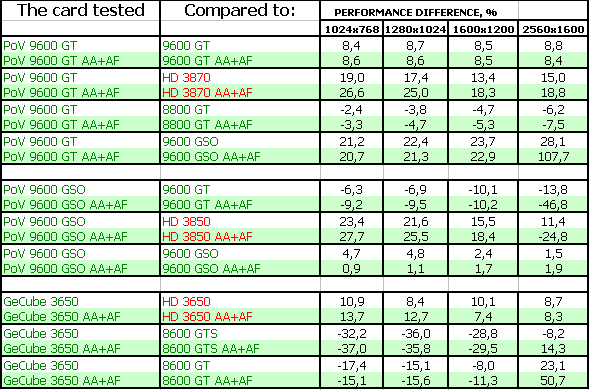 World In ConflictPerformance charts: World In Conflict  Call Of Juarez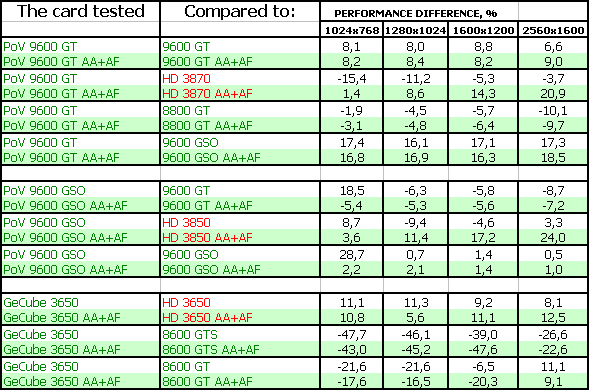 Company Of Heroes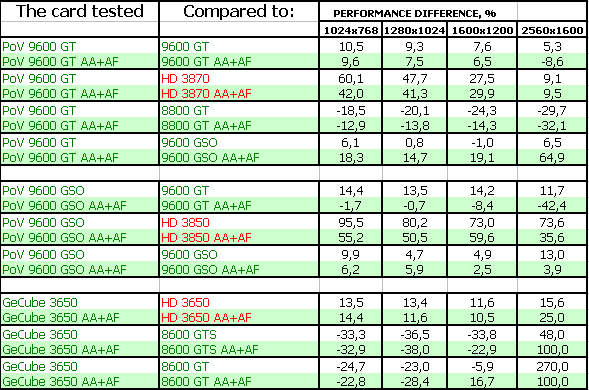 3DMark Vantage: Graphics MARKSPerformance charts: 3DMark Vantage: Graphics MARKS 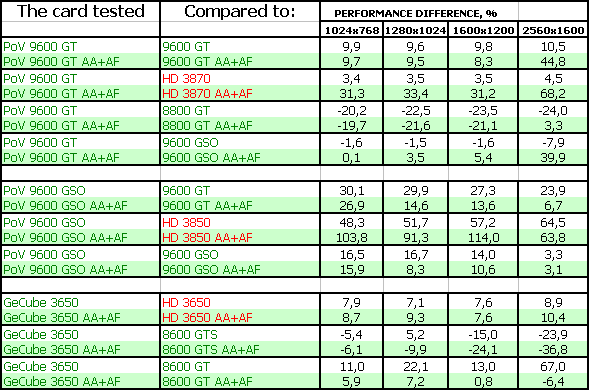 3DMark06: SHADER 2.0 MARKSPerformance charts: 3DMark06 SM2.0 MARKS 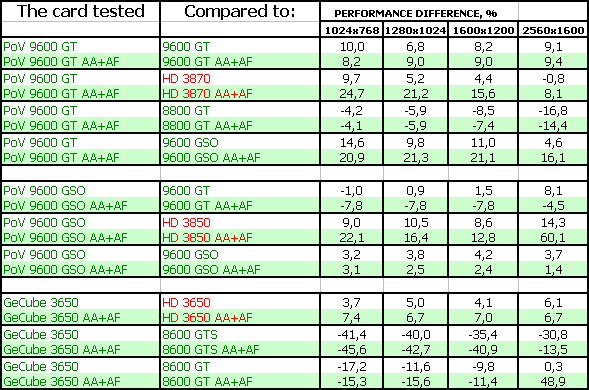 3DMark06: SHADER 3.0 MARKSPerformance charts: 3DMark06 SM3.0 MARKS  ConclusionsI repeat that all cards are divided into three groups (according to price ranges) on charts. Each group is marked with its own color. Point Of View GeForce 9600 GT Wall-E EXD Edition 512MB is a very popular product with an excellent price-performance ratio, like all overclocked 9600GT cards. Add to this an excellent cooling system. A modern popular game in the bundle makes this product even more attractive. Point Of View GeForce 9600 GSO EXD Edition 384MB belongs to the 8800 GS series (aka 9600 GSO). It's still a strange product, because it's apparently outperformed by 8800 GT, but sometimes goes on par with 9600 GT, especially its overclocked modifications. One thing is clear: NVIDIA has to use G92 rejects somewhere. So they go to these cards. Besides, the bus is pared down to reduce performance. So 9600 GSO may be successful only if its price is equal to or lower than that of 9600 GT. Considering that such cards are based on sterling 256-bit PCBs, I can't say it's a very expedient product. What concerns this card from PoV, it stands out with its higher operating frequencies. However, the cooling system is noisy and not very efficient. A game in the bundle can hardly make up for it. GeCube RADEON HD 3650 O.C.Edition 512MB is another RADEON 2600 like modification. But it's equipped with 512 MB of memory. Besides, engineers tried to design a decent cooling system here, which is still too fragile (as all GeCube solutions). You can accidentally skew it, so it will become noisy (as in our case) or it may accidentally fall off, as in 3870 X2. In other respects it's a decent product for its price. AfterwordA few words about our benchmarks. In our updated FRAPS review we have illustrated how crude and inaccurate tests with this utility are. Testers do not have other tools, except for benchmarks built into games. This article and its first part explain that it's sometimes possible to test games with integrated and identically looped demos. Although this implies lots of potential errors, since measurement accuracy depends on a given tester: whether he starts/stops FRAPS in time or does it too late/early. But I have run across situations, when demo load changes abruptly in the very beginning or end. So a half-second delay in starting/stopping the utility changes the average FPS by 15-20%. That's not a measurement error anymore - such a test is a total waste of time. One time you delay the test, another time you start it too early (not intentionally, of course), and you end up with absolutely different performance results. But even that's not the most important thing. The fact is, there are almost no games with built-in demos anymore. So, testers are forced to use a method that we deem totally unacceptable. They measure gaming performance by walking a straight line from the a starting point in a scene to a selected destination (the nearest fence, tree, etc.). We all understand that it's impossible to navigate to a finish spot in precisely the same route with different cards and in different resolutions. Besides, such games always introduce random elements into a scene, and objects may be placed slightly differently on the same scene. Unfortunately, websites that publish a huge number of tests do not always reveal their test methods for each game (except for those with built-in benchmarks). So, we believe that it's better to offer a limited number of game tests, but each will be crystal clear, accurate and showing actual differences between graphics cards. Point Of View GeForce 9600 GT Wall-E EXD Edition 512MB and Point Of View GeForce 9600 GSO EXD Edition 384MB get the Excellent Package award.  We express gratitude to
Point Of View and Gecube for provided graphics cards. PSU provided by TAGAN, Monitor provided by NVIDIA. Write a comment below. No registration needed!
|
Platform · Video · Multimedia · Mobile · Other || About us & Privacy policy · Twitter · Facebook Copyright © Byrds Research & Publishing, Ltd., 1997–2011. All rights reserved. |